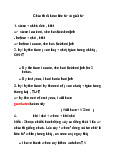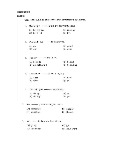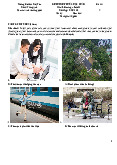



















Preview text:
LISTENING 2
TRƯỜNG ĐẠI HỌC DUY TÂN
KHOA NGOẠI NGỮ
BỘ MÔN: ANH VĂN KHÔNG CHUYÊN GIÁO TR"INH NGHE 2 LISTENING 2 LƯU HÀNH NỘI BỘ Đà Nẵng, năm 2013 1 2 Contents Part 1 Photograph Descriptions Page
Lesson 1 Photographs of People 6 1.1.01 Overview 1.1.02 Statement Analysis 1.1.03 Practice Lesson 2 Photographs of People 17 1.2.01 Common vocabulary
1.2.02 Practice with Possible Statements
1.2.03 Practice with TOEIC Actual questions Part 2 Questions & Responses Lesson 3 Questions with Who 31 2.3.01 Overview 2.3.02 Question Structures
2.3.03 Practice – Questions with Who Lesson 4 Questions with Who 43 2.4.01 Common vocabulary
2.4.02 Practice with possible questions
2.4.03 Practice with TOEIC Actual questions Lesson 5 Questions with Where 47 2.5.01 Overview 2.5.02 Question Structures
2.5.03 Practice – Questions with Where Lesson 6 Questions with Where 57 2.6.01 Common vocabulary
2.6.02 Practice with possible questions
2.6.03 Practice with TOEIC Actual questions Lesson 7 Questions with When 61 2.7.01 Overview 2.7.02 Question Structures
2.7.03 Practice – Questions with When Lesson 8 Questions with When 71 2.8.01 Common vocabulary
2.8.02 Practice with possible questions
2.8.03 Practice with TOEIC Actual questions Lesson 9 Questions with Why 75 2.9.01 Overview 3 2.9.02 Question Structures
2.9.03 Practice – Questions with Why Lesson 10 Questions with Why 85 2.10.01 Common vocabulary
2.10.02 Practice with possible questions
2.10.03 Practice with TOEIC Actual questions Part 3 Conversations
Lesson 11 Questions with Where and What 91 3.11.01 Overview 3.11.02 Question Groups 3.11.03 Practice
Lesson 12 Questions with Where and What 97 2.12.01 Common Vocabulary
2.12.02 Practice with possible questions
2.12.03 Practice with TOEIC Actual questions Part 4 Short T alks
Lesson 13 Questions with Where and What 107 4.13.01 Overview 4.13.02 Question Groups 4.13.03 Practice
Lesson 14 Questions with Where and What 113 4.14.01 Common Vocabulary
4.14.02 Practice with possible questions
4.14.03 Practice with TOEIC Actual questions ___________________ 4 Part 1 Photograph Descriptions
Part 1 of the TOEIC test consists of ten numbered photographs that are printed in your test
booklet. For each photograph, you will hear four statements and you must choose only one
statement that best describes what can be seen in the photograph. This part is comparatively
easier than the others. If you keep practicing, you will be able to unders tand a lot of
statements in Part 1, and you can, t hus, for m a foundation which may be useful for the othe r parts. 5 Lesson 1 Photographs of People 1.1.01 Overview
Photographs of people consist of photographs describing one person and photographs
describing more than one pe rson. In the former, the correct answer must describe the action,
appearance, state, or location of the person in the photograph. In the latter, the correct answer
must describe the action, general state, or location of the people in the photograph, or the
action, appearance of each person. You have to select the s tatement that bes t describes the photograph. Example 1
Choose the statement that best desc ribes the photograph. (A) She is painting a picture. (B) She is sitting on a bench. (C) She is crossing the street.
(D) She is looking at a painting on the wall.
Photograph describ ing o ne person
For this photograph, the correct answer will be the statement that describes the action or
outstanding features of the person. Statement (A) best des cribe s the photograph, which shows
a person sitting and painting. An incorrect answer is the one that employs verbs /nouns
relating to the wrong action/appearance/location of the person, or wrongly describes the
surrounding objects. Statement (B) co rrectly describes the state of the person, w hich is
sitting, but the location is wrongly des cribed. S tatements (C) and (D) are also completely
wrong because of the wrong action (crossing the st reet) and the incorr ect location of the painting (on the wall). Example 2
Choose the statement that best desc ribes the photograph. (A) People are looking at fish. (B) People are fis hing. (C) People a re diving.
(D) People are washing their ca rs. 6
Photograph describ ing more th an one p erso n
The correct answer is the statement that describes the general action, appearance, or location
of the people. Statement (A) describes the general action of the people, which is observing
the fish in the tank. Statement (B) is misleading becaus e of the verb fish. Both statements (C)
and (D) are incorrect because they describe the wrongaction s (diving and washing their cars).
…………………………………………………………………………………………….. Tip! Statement Structures
In Part 1, co rrect answer choices may have one of the five structures below: Structure 1
Subject + is/are + V-ing + o
bject: The person is doing something. -
This most common structu re is used to describe the action o f the person in the
photograph When listening, you should identify the verb in the present continuous tense and its object. Structure 2
Subject + is/are + V- ing + prepos itional phrase of p lace: The pers on is doing something some where. -
You should listen to the prepositional phrase of place afte r the verb, as it pr ecisely
describes the location where the person is performing the action. Structure 3
Subject + is/are +
prepositional ph rase of place: The person is at somewhe re. -
Answer choices with the verb be followed by a prepositional phrase of place are not
very common. However, you s hould pay attention to the prepo sitional phrase of
place, as it -de scribes the location of the person. Structure 4
Subject + is/are + being + p ast participle: The object is being acted on (by the person). -
Even though the focus of the photograph is a person, the subject of a correct
answer choice may be an object used w ith the pre sent continuous passive (be +
being + past participle). This means that the person’s action is emphasized. Y ou,
therefore, s hould pay attention to the object acted on.
Structure 5 Subject + is/are + past participle + adverb : The person i s doing something somewhere.
- The verb in this structure is in the passive form; howeve r, it does not have a passive
meaning. This structure ha s a simila r meaning to Structu re 2. 7 Overview Check up
…………………………………………………………………………………………….
Listen and choose the statement that best describes each photograph.
(A) A man is taking a picture. (A) She is reading a book.
(B) A man is in an art galler y (B) She is holding a map. (A) A public phone is being used. (B)
A woman is us ing her cell phone.
(A) The woman is filling out some papers.
(B) The woman is standing at a copier. 8 (A)
The women are looking at each other. (B)
The women are seated side by side.
……………………………………………………………………………………………
Answers and explanations 1.
(A) The correct answer to this question has the s tructure Subject + is + V-ing + object. The
object in this photograph is book. hold . map 2.
(B) The correct answer to this question has the structure Subject + is + prepositional phrase of place. take a picture art gallery 3.
(A) The correct answe r to this question has the s tructure S ubject + is + being + past participle
(the present continuous passive). public phone cell phone 4.
(B) The correct answer to thi s question has the structure Subject + i s + V-ing + prepositional phrase of place. fill out copier 5.
(B) The correct answer to this question has the structure Subject + are + past participle + adverb. each other seat side by side 9 1.1.02 Statement Analysis Example 1
A photograph of one person: The subjects of all the statements are alike and refer to the person in the photograph.
When the person in the photograph is a male, the subject will be He/The man/A man. When
the person in the photograph is a female, the subject will be She/The woman/A w oman. As
all the subjects in the statements are alike, you have to listen to the verbs and their objects or the remaining details.
Test-Taking Strategies
1. The correct answer choice should de scribe the person’s outstanding action, appea rance, state, or location.
2. The most important element in all statements describing photograph s is the verb itself.
You may hear certain new verbs. You, thus, should practice listening to and learn typical verbs.
3. You should also carefully observe the pers on’s appearance and clothes. Afte r identifying
the verbs in the statements, you mus t listen to the remaining details. Sometimes, the correct
statement describe s the clothes he/she is wearing or the accessorie s he/ she i s bringing.
4. You mus t distinguish between “action” and “state”. Take the verbs wear and put on as
example s: wea r is used to describe the “state" of having clothe s on, while put on refers to the
"action” of getting dre ssed. 10 Example 2
A photograph of one person: The subjects of the s tatements refe r to either the person or the
objects/scenes in the photograph.
(A) Some book s are stacked on the
floor. (B) The man is reading a book.
(C) All of the chairs a re occupied.
(D) Some people are sitting on a bench .
The s ubjects in the statements are different, which caus es mo re difficulty for you. You have
to carefully observe not only the pe rson's action/ state but also thing s around and even the
background. In most cases, the correct answer choice is the one w hich describes the
action/state of the person in the photograph. Therefore, if you are unsure, choose the
statement whose subject i s the pe rson in the photog raph.
5. Sometimes, the name of an object is not specifically stated but a general term is used
instead. For example, the pers on in the photograph is playing the guitar or piano; the correct
answer choice may use a musical ins trument - the general term of guitar and piano. You
should familiarize yourself with some other general terms such as tools, equipment, vehicles, fruits, etc.
6. You should not interpret. Just carefully look at the photograph and decide which of the
statements best describes what you can see in the photogr aph.
7. You mus t also obs erve the things around the person. S ometimes, the main focus of the
photograph is the person, but the correct answer choice may concentrate on the objects or scenes.
8. In the actual test, all the photographs are in black and w hite. Therefore, nearly all of the
statements which mention colors will be incorrect answers. 11 Example 3
A photograph of more than one pe rson: The subject s of all the statements are alike and refer
to the people in the photograph.
(A) They are getting up from their chairs.
(B) They are enjoying some snacks .
(C) They are sitting a round the table. (D) They are arranging chairs.
When the photograph includes both males and females, the s ubject mentioned will be They.
When there are only males , the subject will be The men. When there are only females, the
subject will be The women. As the subjects of all the statements are alike, you have to listen
to the verbs and their objects or the remaining details.
Test-Taking Strategies
1. You must observe the general action/ state of the people in the photograph. Listen to not
only the verbs but also the prepositional phrases of place.
2. Sometimes, you must also pay attention to the appearance or action of an outs tanding individual in the group.
3. The correct an swer choice generally describes what the people in the photograph are doing
together, or what a focused pers on in the photograph is doing. 12 Example 4
A photograph of more than one person: The subject s of the statements refer to either the
group of people or the objects/scenes in the photog raph.
(A) The intersection is full o f cars.
(B) The people are c rossing the street. (C) They are w alking into the building.
(D) Lines are being painted on the road
- The correct answer choice may describe the general action/s tate of a group of people, o r it
may focus on an individual. When it refers to a group, the subject may be They, The people,
Some people. When referring to an individual, the subject may be A man/woman, O ne
man/woman. While listening, you must decide w hether the subject and verb correspond to
the people’s action/ state or not. You must also keep an eye on the objects o r scenes in the photograph.
4. you must make sure that the subject and verb in the answe r choice bes t describe what you can see in the photograph.
5. You must be very cautious because incorrect answers may sometimes be those that
mention the most outstanding object in the photograph. 13 1.1.03 Practice
Listen and choose the statement that best describes each photograph.
(A) The man is w atering the plants.
(B) There are leaves on all o f the trees.
(C) He i s putting the hose away.
(A) Some people are w alking on the path.
(B ) They are riding their bicycle s uphill.
(C ) Bicycles are parked along the path.
(A) Vegetables are being placed on the
table. (B) The food is in he r s hopping cart.
(C) S he is shopping for some produce.
(A) They are taking the elevator
down. (B) They are going do wn the
escalator. (C) They are w alking Vocabulary 1. water 2. path 3. vegetable 4. elevator plant bicycle place go down put away uphill produce es calato hos e pa rk r walk along down steps 14 (A) The man is getting out of the (A) They are moving in a line.
vehicle. (B) The man is standing bes ide (B) They are sitting on the
the car. (C) The man is parking his car. ground (C) They are climbing over a wall.
(A) A truck is moving down the
s treet (B) The street i s filled with cars.
(C) Some people are in the street.
(A) The front of the house is being
painted. (B) A man is working on the roof. Vocabulary 1. get out of 2. move 3. be filled with 4. front vehicle in a roof beside line ladder park ground go up climb over wall 15 16 Lesson 2 Photographs of People 1.2.01 Common vocabulary
First, listen to the words in the box. Then, listen and fill the missing w ords in the gapped statements below. Verbs 1
Frequency of correct answer choices stand s it kook at wea r look in play look out use look through face hold paint work [Check-up 1]
1. The people are…standing…………by the airplane.
2. The man is……looking at………..the computer screen
3. She is………looking in……….a drawer.
4. They are……looking out………….of the
window. 5. The man is …looking through………..a telescope.
6. H e is…holding……..a book in his hand.
7. H e is………working……..a bicycle.
8. H e is………sitting……alone by the water. 9. She is… …gla wearing sses .
10. H e is……playing…..an instrument.
11. The woman is……using….. laboratory equipment.
12. The audience is……facing.. the front of the room.
13. S he is………painting……a picture. carry push cross reach for examine read handle talk move walk pack 17 [Check-up 2]
1. They a re………carrying…..Bags on their shoulders
2. Some people are……crossing…..the s treet.
3. She is…………examining……….some produce.
4. The man is……handling……a patient.
5. They are...……packing….a box.
6. They are……moving….. in a line.
7. She is……pushing……a suitcase.
8. The gardener is…reaching…an empty wheelbarrow.
9. She is….reading…..a book.
10. The man is…reading…a newspaper.
11. They are……talking…..each other.
12. A woman is……walking…..a dog on the shore. Verbs
2 Fr equency of correct answer choices change eat clean enter cook exit deliver fi sh do focus [Check-up 3]
1. The woman is…changing…….. a light bulb
2. She is……cleaning………… the boa rd
3. He is………cooking……. s ome food
4. She is…delivering………… the mail.
5. He is………doing……. construction work
6. She is……eating……… a meal
7. They are………entering…… a building
8. A passenger is……exiting…….. the taxi
9. He is…fishing…. from a boat
10.The group is ……focusing…... on the computer screen gather sign gaze at lay get out of lean go up lift greet light 18



